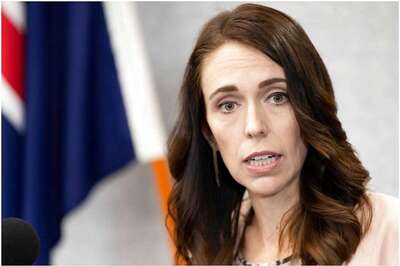
views
The UNCCD was born 25 years ago with the explicit focus on desertification in Africa — a concern that has become a global one, with India particularly impacted. India hosted the UNCCD’s fourteenth conference of parties (COP 14) earlier this month and has seen nearly a third of its area - effectively twice the size of Spain - degraded through deforestation, soil erosion or depleted wetlands.
Consequently the threat of drought, and a host of negative impacts from climate change hangs over India, as the national GDP continues to be whittled by 2.5 percent annually.
At the end of “The New Delhi declaration”, which saw the issue of drought take centre stage, participating countries agreed that land degradation was a major economic, social and environmental problem, potentially crippling global economies. They welcomed the strengthening of the adoption of voluntary “land degradation
neutrality” targets, including the restoration of degraded land by 2030.
News18 caught up with Barron Joseph Orr, who has been at the heart of the world’s battle against desertification and interviewed him regarding the importance and import of desertification, land degradation and land degradation neutrality.
Edited excerpts:
Q: What exactly is land degradation neutrality (LDN)?
A: Land degradation neutrality is a very, very different way of looking at land degradation than in the past. In the past when we looked at land degradation, we looked at it where we saw the problem and tried to fix it. This made a lot of sense. So, we are talking about restoration and rehabilitation…wherever possible, we would protect land and we would avoid land degradation entirely.
But because this was not a holistic approach we were not keeping up with new degradation. So even though, since the 1960s when we first got started on this, our skill set and our science and technology for restoration and sustainable management and protection is really high…that isn’t the problem anymore. The problem is that we are in a world of land transformation. The IPCC report…they're all telling us that 70-75 percent of land surface of the earth has already been transformed from its natural state. That isn’t necessarily bad…we are talking about agriculture (for instance)…but the problem is that among that one in four hectares isn’t usable. It is degraded.
So we have a transformation that has reduced, if you will, the total natural capital of the world. But if we are degrading a big chunk of it, then we are headed towards a train wreck. Because we can't continue like this. A greater concern is that the rate of transformation is increasing…
So that is where land degradation neutrality comes into that story. Well, twenty years after the Earth Summit at Rio De Janerio in 1992, countries said let us try to pursue this where we don’t get worse in net terms. That was just a marketing idea…the real starting point, what is the foundation…all of that was agreed in COP 2017 (UNCCD COP 13 in China).
Q: So what are the barriers?
A: There are a lot of barriers. Very rarely, today, do we have municipal planners, agriculture planners and conservation planners in the same room. Why? Because the planning process is the same as the old degradation process…it’s not that someone is trying to do harm but, it is their job. They are supposed to do that. But we can change that.
Secondly, very rarely are land administration systems linked to environmentally monitoring data. If that happened, you could simply overlay these and look at the underlying potential of the land and make better decisions. You could say, wait a minute…restoration is unlikely to succeed here but maybe we could put the biology back in the soil and we could get going again…we have these options. It isn’t simple, but it is doable.
It is not a challenge that we couldn’t organize ourselves in a more holistic way.
Q: So how is it different from before?
A: Because it says that we need to look at land holistically…we need to optimise, what we in our world, call interventions. To give you a simple example, high contrast example…with urban areas you know there is going to be urban expansion. If there is agricultural land here, and degraded over there - the urban land ends up taking place on prime agricultural land. That is a guaranteed LDN loss. You are removing ecosystem services, basically food. But if you look at all land…we would try and push that into degraded land and using smart growth techniques we could even have a gain through mixed vegetation, habitat, corridors, etc. It isn’t simple, but it is doable.
The sustainable development goals, life on land is one of them. When we think about things like carbon in the atmosphere or biodiversity, it is very easy to think about net carbon, or biodiversity offsets. But we never think of land as a limiting resource. But today it is.
Many people feel that co-related land rights to stewarding land good….but if you look at the data it isn’t so clear. Buy why, the SPI (science-policy interface) figured out by looking at the data that there are other aspects of the enabling environment that could short circuit what is an obvious connection, right. So, say your incentives right now are pretty much for large farms, but your goal is small farms. But how are you going to get over the hump, of whatever it is that they’re doing, say fertiliser…for the farmer it is better to sell the land off, so that he has something to give to the kids. So the recommendation says, hold on.
Q: What about monitoring?
A: We look at the problem of monitoring level, from a national to global perspective, but it won’t make any sense for the country unless we do the next step, which is national to local.
So for the national to global, we use an approach that would be called an essential variable approach, we don’t use a comprehensive monitoring. Because, in 2009, when we did a survey of all the countries in the world, on what they were using to monitor land degradation - they came up with over 1,500 unique indicators. Because every location, the problem is a little bit different. So then the convention said that this isn’t the approach. We have to go the other way….at the national and global level, they don’t have to be comprehensive. It’s just, are we doing better or worse.
They chose, the COP chose, three land based indicators - which are related to each other in important ways. One of them is what we would call a transformational variable - land cover change. If the land cover changes, then we have got a potential for big problem - but it could be manageable. Second is the fast ecological variable - productivity: it’s the productivity of the land and its fast because, for instance, a little rainfall could raise the productivity. Then we have a slow ecological variable, that is the soil ecological carbon - and it’s a really intriguing variable.
Because if it (carbon) is not in the soil, it’s in the atmosphere. Because if it’s not in the soil, the soil is dead. If the soil is dead, then the biodiversity is next to impossible, and if it is not in the soil…you’re constantly applying fertiliser and eventually you will exhaust it.
This story is part of Covering Climate Now, a global collaboration of more than 250 news outlets to strengthen coverage of the climate story.




















Comments
0 comment